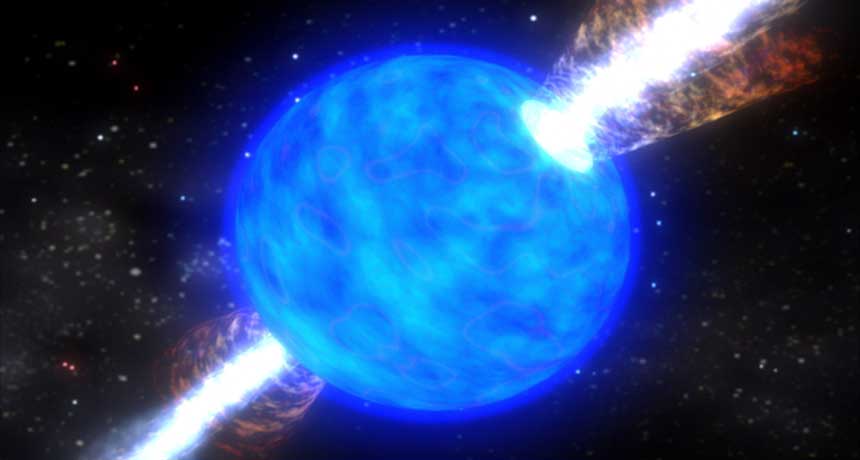Dying stars can make gold as they collapse into black holes
The spinning orbs may help to explain the origin of such heavy elements in space

A collapsar is a massive, spinning star that collapses into a black hole. That collapse releases a blast of light known as a long gamma-ray burst (illustrated). It also leads to an explosion in the star’s outer layers.
NASA Goddard Space Flight Center
Gold may be a glittery leftover from a newborn black hole’s messy first meal.
Gold is a heavy element. So is platinum. And uranium. These and many other heavy elements might form when rapidly spinning, massive stars collapse into newly formed black holes. Known as collapsars, these stars get their name from that collapse. And as this last dying stage of their lives take place, layers of gas around them explode. That collapse and explosion leave a disk of material swirling around each new black hole. When that black hole devours the surrounding material, the conditions become just right for gold, platinum and other heavy elements to form, scientists now report.
“Black holes in these extreme environments are fussy eaters,” says Brian Metzger. He is an astrophysicist at Columbia University in New York City. These black holes can gulp down only so much matter at a time. What they don’t swallow blows off in a wind. This wind has lots of neutrons — subatomic particles having no electric charge. With a lot of them in the wind, it makes just the right conditions for the creation of heavy elements, Metzger says. At least that’s what simulations from his team’s new computer model suggest.
Metzger and his colleagues described those simulations and their results online May 8 in Nature.
Cooking up the elements
Their team has been trying to answer an age-old question: Where do the heaviest elements in the universe come from?
Astronomers know certain elements form inside stars and then spew into space when dying stars explode. These are elements such as carbon, oxygen and iron. Scientists call these light elements as they have less mass than those such as gold and platinum.
Stars can’t make elements that are heavier than iron (like gold and platinum). To get such heavies there’s got to be a lot of neutrons. And they’ve got to be packed together tightly, creating an extreme environment. And in it, the centers of atoms — nuclei — absorb neutrons. After absorbing a lot of them, an atom’s nucleus will become unstable. To stabilize itself once more, it undergoes radioactive decay. In that decay, a neutron changes into a proton. And that makes a new element. Astrophysicists refer to this chain of reactions as the r-process.
Scientists had suspected that elements made this way could emerge when two stars collide. Specifically, it would happen when the smashup involves two dead stars known as neutron stars.
Good evidence for the idea came out almost two years ago. That’s when astronomers spotted a collision between two neutron stars. It made waves that stretched and squeezed spacetime — the fabric of space. Astronomers call the ripples gravitational waves. Studying the smashup showed the neutron stars did spew out heavy elements, including gold, silver and platinum.
But the neutron-star idea explanation has shortcomings. Dense, dead stars can take a long time to collide. Heavy elements, however, have been found in ancient stars, ones that formed in the early universe. It’s not clear whether a neutron-star merger could happen that early in the history of the universe. But it would have to in order to explain the elements’ presence in those early stars.
Very old black holes
So if there weren’t neutron-star smashups back then, what made the heavy elements? Scientists think spinning stars that collapse into black holes — collapsars — could have occurred in the early days of the universe. And that process could be a prolific maker of heavy elements.
A single collapsar might generate 30 times as much r-process material as a neutron-star merger. A collapsar could generate a few hundred times the Earth’s mass in gold, Metzger now says. Collapsars, therefore, might be responsible for 80 percent of elements made by the r-process. Neutron-star mergers would make up the rest, Metzger and his colleagues suggest.
Their results shed new light on a 2016 discovery about a dwarf galaxy called Reticulum II. Its stars are rich in heavy elements. That means some type of catastrophe happened in the galaxy billions of years ago to make all those heavy elements. Scientists had thought an ancient neutron-star merger seeded this galaxy with those elements. A collapsar now becomes another candidate.
“It’s very exciting,” says Anna Frebel. She is an astrophysicist at the Massachusetts Institute of Technology in Cambridge and a coauthor of the 2016 study on Reticulum II. Neutron star mergers are rare. So “it felt a little bit like we were proposing to win the lottery,” she says. But collapsars are even more rare. For every 10 neutron-star mergers, there’s one collapsar. So, she notes, if collapsars are the explanation, “it feels like we’ve won the lottery twice.”
It’s still not clear if collapsars happen frequently enough to explain the abundances of heavy elements seen throughout the universe. It’s also not clear if they produce the right amount of material. “I think the jury’s still out,” says Alexander Ji. He is an astrophysicist at Carnegie Observatories in Pasadena, Calif. He coauthored the 2016 paper on Reticulum II.
“Now we’re really excitedly thinking about how you might be able to tell the difference,” Ji says — whether collapsars or neutron stars better explain galaxies such as Reticulum II. Future observations of the aftermath of collapsar explosions could be helpful. They could help nail down collapsars’ role in shaping such galaxies. The observations also might reveal whether collapsars really do litter the universe with heavy elements.







